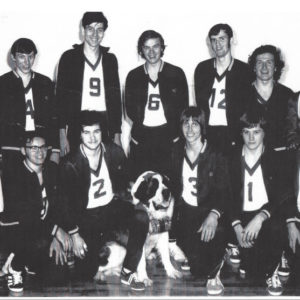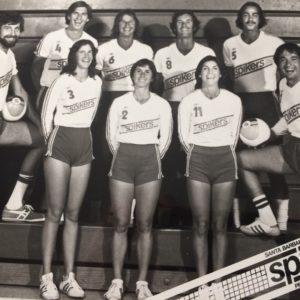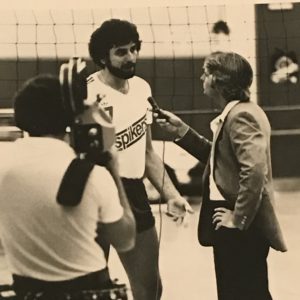
Welland resident shares Games’ memories
Fifty years after competing for Ontario in volleyball at the Canada Winter Games, the memories are still fresh for Peter Stefaniuk.
“It was the first time I was ever chosen for a select team so that was in itself, almost like a stepping stone for me being chosen for Ontario,” the 68-year-old Welland resident said. “At those national types of tournaments, that is when you get people watching you. It was an eye-opener for me, having different universities coming up and asking me what my future plans were and all that kind of stuff.”
Stefaniuk still has his mementoes from the 1971 Games in Saskatoon, Sask., where he was part of Ontario’s men’s volleyball team.
“I have a certificate from the Ontario government and I still have my medals. We won silver in men’s volleyball and then, as a province, Ontario came in first so I have a gold medal as well.”

The Toronto native had big plans to celebrate the 50th anniversary of the silver medal this year but those were put on hold by the COVID-19 pandemic.
“There is only one of us who is not around any more and I was hoping to host a 50th anniversary lunch at my place in Welland and then go over to the Games,” he said. “But that will have to wait until next year because the Games won’t happen until next year.”
Volleyball has been moved to the Summer Games and Stefaniuk can’t wait to take in the fast-paced action next summer in Niagara.
“I hope people are excited, especially for volleyball. At the Olympics, it is one of the most sought-after tickets you can find because it is so exciting, so fast and the athletes are just so coordinated and agile, both men and women,” he said. “I know that volleyball is going to be one of the featured sports at the Canada Summer Games and I am looking forward to that part of it.”
Stefaniuk will surely be remembering his Canada Games experience when the event come to Niagara in 2022, especially the 1971 host.
“That was really interesting because, as you know, the geography of Saskatchewan is pretty flat and these were the Canada Winter Games. To hold the skiing events, they built a big mound of garbage and put snow on it.”
The athletes village was located in an abandoned six-story Simpson-Sears department store.
“They put hundreds of tents on each floor and that’s where we stayed. I believe we were on the fifth floor and we were four to a tent.”
Stefaniuk’s Canada Games experience is part of an impressive volleyball resume that includes: being selected to play for Canada on a team that won Canada’s first-ever medal in a qualifying tournament at NORSECA (North, Central America and Caribbean Volleyball Confederation) in Tijuana, Mexico; playing in the coed, pro International Volleyball Association for the Los Angeles Stars, Tuscon Sky, Santa Barbara Spikers and Albuquerque Lazers; serving as head coach at the University of Toronto, Ryerson and George Brown College, and with countless teams during his 30-year career as a physical education, health and special needs teacher with the Toronto Public School Board; Ontario Federation of School Athletic Association’s gold medals in 1969 and 1971; 1974 Ontario Open senior AA gold medal; 1975 and 1981 Ontario senior AA gold medals; 1988 Ontario Open senior gold medal; gold medal at the senior nationals in 1975 with SA Ukraina; being named to the Ukrainian Sports Hall of Fame; and, authoring numerous articles on drill concepts and running tryout camps.
His highlights are many.
 “I look at it as a cumulative thing. Being recognized to play for Canada was a big deal for me to being drafted and playing in the pro league was excellent. Coaching at U of T was great but probably the most fun I had was watching my son, Alex, play and win national championships. I got more out of that in the long run by watching him grow as a young man and playing the sport as well.”
“I look at it as a cumulative thing. Being recognized to play for Canada was a big deal for me to being drafted and playing in the pro league was excellent. Coaching at U of T was great but probably the most fun I had was watching my son, Alex, play and win national championships. I got more out of that in the long run by watching him grow as a young man and playing the sport as well.”
Alex played for the Pakmen organization and Humber College.
Competing in the pro league was a thrill for Stefaniuk. It featured international stars such as Olympic champion Ed Skorek, world champion Stan Gosciniak from Poland, Bebeto from Brazil, NBA great Wilt Chamberlain and the top women’s players in the world. The league lasted from 1975 to 1980.
“That was a great experience as a 22-year-old kid in 1975. I had just won the national championship in Canada with my club team in Toronto and then I was chosen by the Los Angeles Stars in the draft. I ended up being part of the IVA’s inaugural championship team.”
The league ran from May through to the second week of August.
“It was considered like a Hollywood league because our owners in Los Angeles were two big shots. One was David Wolper, who owned Wolper Productions, and the other one was David Gerber, who was an executive producer at CBS. The San Diego team was owned by the Motown Records president, Berry Gordy.”
Those connections led to some interesting team parties.
“I got to meet Diana Ross, Connie Stevens, Wayne Rogers and several other actors. They were working for or were friends of the owners and they would come to our team parties to bring some notoriety to it.
“Wilt Chamberlain was the commissioner at one point and he played volleyball as well. I played with him in the 1978 all-star game in El Paso, Texas, That was a lot of fun.”
 Like many pro leagues at the time, being an athlete wasn’t very lucrative.
Like many pro leagues at the time, being an athlete wasn’t very lucrative.
“We didn’t make a lot of money but I imagine some of the player coaches made 20-25 grand. The players were mostly making three to five grand the first couple years, By 1980 in Albuquerque, I was making 20 grand as a player and assistant coach.
“We were pioneers and we had to deal with the finances being what they were.”
In Canada, Stefaniuk went to York University and played one year there and making the national finals. After one year, he was given carding money by the Canadian national team.
“They were paying me $1,800 a year to play for Canada and, because of that, I had to give up playing university ball and all other sports. Times are different now. They encourage you to play elsewhere but back then they were worried that you might get hurt.”

























